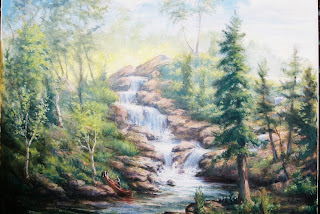The Macchiaioli were a group of nineteenth century Italian painters who met at the Café Michangelo in Florence and developed a unique approach to painting. Though they were influenced by the French Barbizon school, and tended to criticize the academic method of their day, the Macchiaioli method of painting can trace its origins to the Italian Renaissance, and the works of Leonardo Da Vinci. In his Treatise on Painting, Leonardo describes how artists can study stains (macchie) on walls to stimulate their artistic imaginations. (p. 222 Leonardo on Painting, Yale University Press, 1998, New Haven and London, edited by Martin Kemp) Moreover, Leonardo used the idea of the macchie to create amazingly varied, nuanced and mysterious shapes that seem impossible to define, and yet perfectly describe form, texture, character and mood. Leonardo referred to this type of chiaroscuro painting as smoke. (Try to delineate the shadow silhouette of the Mona Lisa and you will understand.)
The Macchiaioli artist realized that the academic approach of modeling delineated conceptualized forms could not capture the nuanced and varied effects of light within a scene. They also recognized the limits of pigments to matching the amazing range of colours in nature. Inspired by Leonardo, they emphasized an exaggerated chiaroscuro to capture the range of colours in nature and the macchie as a way to describe the effects of light.
I first encountered the works of the Macchiaioli painters while studying painting with Michael John Angel in Florence, Italy. Maestro Angel’s teacher, Pietro Annigoni, was associated with the Renzo Simi, who’s father Filadelfo was a Macchiaioli painter. At the time, I was not aware of the significance of our meetings with other students of Annigoni at the Café Michangelo. Apart from my interest in my own artistic linage, the Macchiaioli paintings that I saw in Italy transformed the way that I thought about painting.
Painting Flowing Water
Flowing water, whether the torrential runoff of the spring thaw or a slow meandering stream is synonymous with the passage of time. “ You can never step into the same river twice” said Heraclitus, because the river is constantly changing. This paradox of constancy and flux presents the greatest challenge to the artist. Stop action photography never represents the river we experience. Sitting by the river bank, hypnotized by flow of currents and waves that splash over rocks with a spray of white water and swirling foam, I notice, amid the constant flux, dynamic patterns of reflections and forms emerging from the dark murky depths.The paradox of painting flowing water can only be resolved through the Macchie, a shape that does many things at once.
As I began plein air painting, I soon realized the limitations of the conventional academic approach to painting.
 |
| F. J. Dvorak: Silent Creek Waterfall |
 |
| F. J. Dvorak, Autumn Burleigh Falls |
 |
| F. J. Dvorak, Burleigh Rapids |
No comments:
Post a Comment